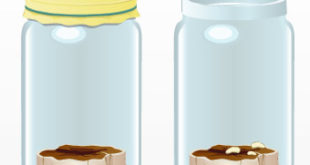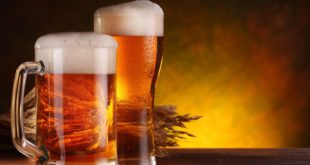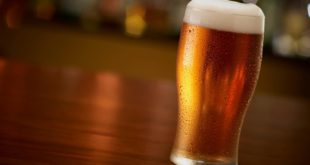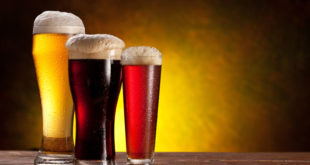| Beer Style: | porter, spiced beer | |
| Recipe Type: | extract | |
Description:All the beer I make is from dry malt extracts and specialty grains. I don’t have the time to do, or the space to set up for, all grain brewing. I like to use Maple Syrup if possible (if I’ve got the cash, about $7 a quart) for dark beer. Not for the flavor, as a quart doesn’t effect flavor much if at all, but because I’ve found it enhances attenuation, how complete the fermentation ends (something in it the yeasties like). The beer generally ends up more “dry” if I use maple syrup. I like clean malt character without sweetness. The beer I’m describing ferments out to 1.004, that is a clean ferment for the amount of grains used. | ||
Ingredients:
| ||
Procedure:Put the grains in a BIG grain bag so they have plenty of room to allow water to flow between after they swell up. Put the grain bag in the cold water and bring the heat up to 160 degrees F. “Steep” the grains like a big teabag. Mix the grains around by squishing the outside of the bag with a spoon, lift the bag out to drain the water with the goodies into the pot. Mix squish and drain the stuff every 5 minutes for an hour. DON’T let the temperature exceed 170 degrees F during the steep to keep tannin extraction (creates a bitter flavor, especially with roasted and black grains) to a minimum. Pull out the grains and set them in a colander that hangs in the rim of your pot and pour a half gallon of clean water through them (preferred), or put them in a colander in a bowl so you can capture the stuff that runs out and add it back to your boil. I use pellet hops. Keep them in the fridge and use them as soon as possible. When done steeping the grains I add the first batch of hops (1 oz for this beer) and bring the water to a boil. Turn off the burner, add the Malt extract and stir it in till completely dissolved. Turn the heat back on, bring to a boil and check the clock. Depending on style you’ll add different hops at different times. This recipe calls for 1 oz Perle at 60 minutes and 1 oz Perle at 30 min. You put the 60 min oz in first, then when there is 30 min left to the boil you add the second oz (add the spices here and maple syrup at end of boil for this beer). Boiled hops add the bittering character, some recipes call for hops at end of boil (sometimes called knockoff) which add aromatic character, some at transfer to secondary which really contributes to herbal or floral aromatics. A note regarding the boil, though a watched pot never boils, an unwatched pot of boiling wort will boil over – WATCH IT. Cooling and Transferring to Primary: Folks use all kinds of containers and techniques to cool and ferment, its a matter of choice. This is what I do. Transfer the pot to my kitchen sink, fill the sink with ice and cold water. Put 2 gallons of fermentation temp water (yes I chill water for lagers, I have been called compulsive) in a sanitized bottling bucket. Add the wort when it is cooled to fermentation temp and add water to 5 gallons (measure and make gallon marks on the outside of your bucket using tap water). I fill the bucket to about 1/2 inch above the 5 gal mark because the valve at the bottom of the bucket is about 1/2 inch above the bottom. Let it set for 30 minutes for solids to settle to the bottom of the bucket. Drain the wort into a 5 gal carboy leaving the solids (trub) at the bottom of the bucket. I use glass to keep characteristics from the last fermented batch, which plastic can retain, from getting into the next batch. Add (pitch) the yeast starter and set up a blow off tube. Primary Fermentation: When the yeast starts working you’ll get a bunch of foamy gack (krausen) blowing out the tube. When the krausen subsides replace the blow off tube with an airlock. When the airlock activity slows (one bubble in 2 seconds for ale temp, one in 6 seconds for lager temp) use a racking tube to transfer (siphon) the stuff to a secondary fermentation carboy splashing as little as possible to minimize oxygenation. Secondary Fermentation: Here’s where you add dry hops for secondary, sometimes spices or fruit. At lager temps I prepare hop pellets by boiling 16 of water, adding the pellets to the hot water, and pouring the green goo into the secondary fermenter before racking. At low temps pellets can float around the top like rabbit pellets and never really break up. At ale temps just toss them in. The action of racking often adds a trace of oxygen, fermentation picks up just a little, and/or forces some carbon dioxide out of solution, and the airlock activity may pick up a little. I do a secondary fermentation primarily for dry hopping and to help clarify the final brew (my beers normally have a light dusting of yeast at the bottom when finished instead of a 1/4 inch of murk found in some homebrews). I let it set a day or two after fermentation is complete and the hops (if I used any have settled). Rack to the bottling bucket and DON’T SPLASH – minimize oxygenation. If I dry hop I have a fine nylon netting which I sanitize and put over the end of the racking cane before transferring to the bottling bucket. Bottling: Carefully add 3/4 cup corn sugar boiled in 16 oz water to the bottling bucket and stir without splashing with a long sanitized spoon getting agitation from top to bottom of the bucket to ensure consistent priming. Bottle it. Bottle Conditioning: Bottle condition, to develop carbonation and such, at the appropriate temperature. Room temp for ale, lager temp for lager. Ales need 1 1/2 to 2 weeks (sometimes less if you’re desperate), lagers from 3 to 4 weeks. This is my beer making ritual. I’ve been doing it just like this for over 3 years with never a spoiled batch. Always drinkable, often great, and sometimes excellent results. Every experienced homebrewer develops their own brewing rituals and preferences for ingredients and equipment. The matter of which is better is largely subjective. | ||
Check Also
Sam Adams Clone
Ingredients: 3.3# Northwestern UK Light Malt Extract 2# Northwestern Amber DME 1 oz – Tettnang …
 Pasteur Brewing Louis Pasteur – Science, Health, and Brewing
Pasteur Brewing Louis Pasteur – Science, Health, and Brewing 


